The team at OpenAI just launched AgentKit, a new suite of tools to help developers build AI agents. This is an incredible launch, and we want to congratulate them on their ever-expanding catalog of high-quality products that empower developers.
A key part of AgentKit is Agent Builder, a visual workflow tool for creating agents that shares some similarities with Langflow. In this post, we're going to take a closer look.
Our goal isn't to declare one tool "better" than the other. As engineers, we know the real answer is always "it depends." Every tool comes with its own set of trade-offs. By building the same agent in both platforms, we can explore these trade-offs firsthand, helping you choose the right tool for your specific job.
Let's dive in by building a simple agent in Langflow and then replicating it in OpenAI's Agent Builder.
The Use Case: A Simple Calendar Agent
To keep things clear and concise, we'll build a simple agent that can manage a calendar. This is a great example because it's a practical task that requires integrating with an external tool (like Google Calendar). This showcases core agentic capabilities: if an agent can connect to a calendar, it can connect to any other enterprise tool you might need.
Building with Langflow
First, let's build the agent in Langflow 1.6. Open up Langflow and follow these steps
Start from Scratch
Begin with a blank flow to ensure a fair comparison, though both platforms offer templates to get you started faster.
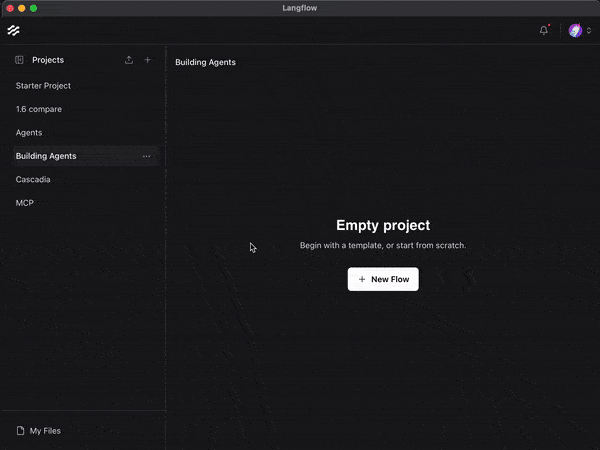
Set up the Flow
Add a Chat Input and a Chat Output component, which form the basic interface for our agent.
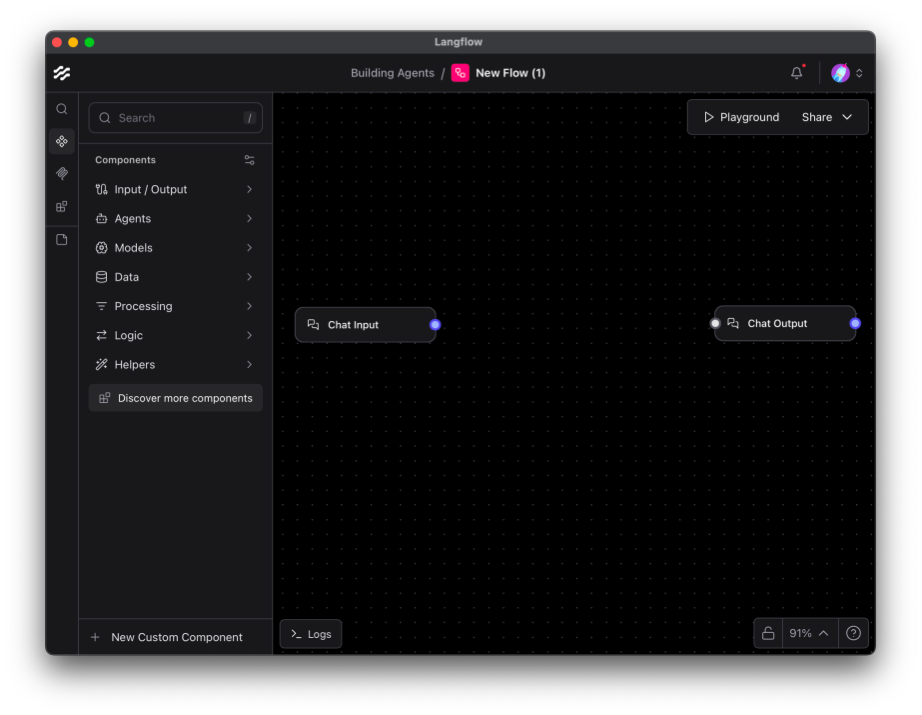
Add an Agent
Add the Agent component and configure it to use GPT-5 to match Agent Builder. You will need an OpenAI API key for this step.
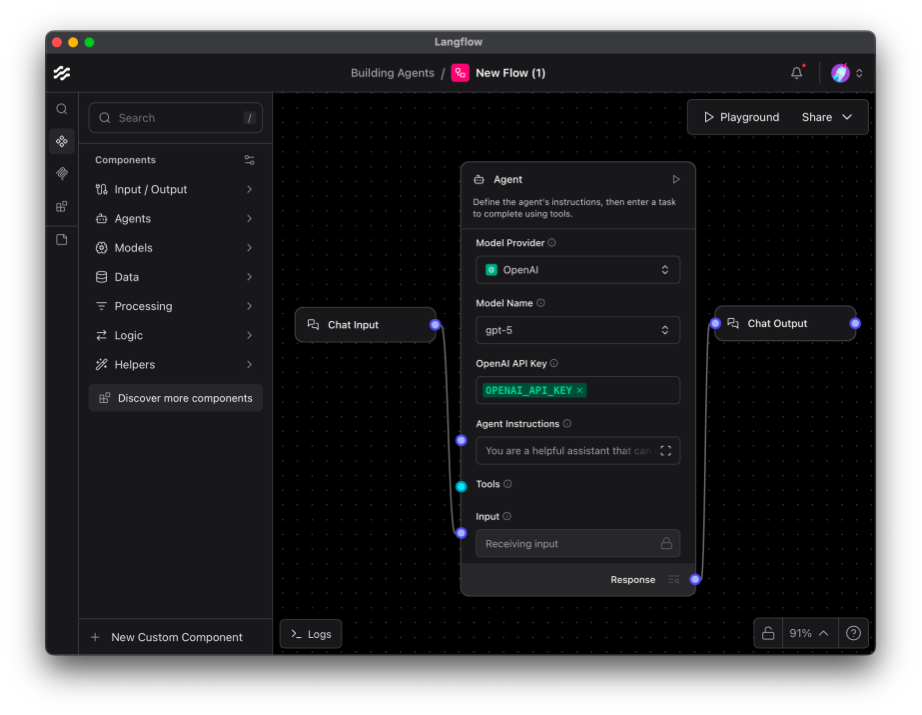
Add Tools
Composio is one of Langflow’s available bundles and provides a vast library of integrations. From the Composio bundle, select the Google Calendar component and enable all of its available actions (create, delete, search events, etc.). Connect the tool to the agent.
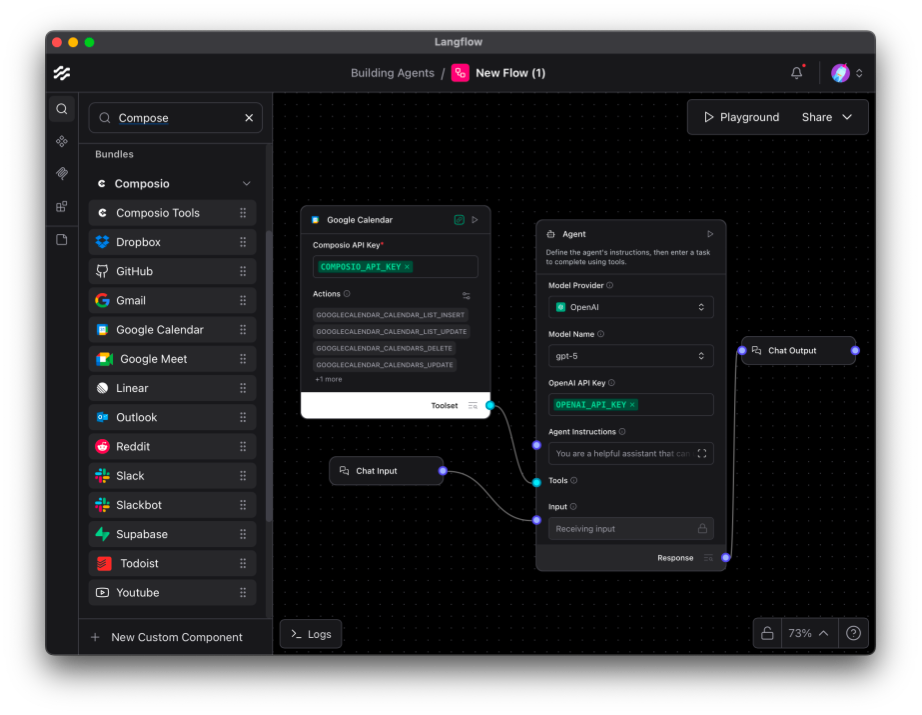
That's it. Our calendar agent is ready.
Let's test it in the playground. Prompt it with something like:
"Create a lunch event for 1 PM, October 13th, 2025 in London for 30 minutes in my calendar."
The agent processes the request, invokes the Google Calendar create_event tool, and a moment later, the "Lunch" event appears on my calendar. Success!
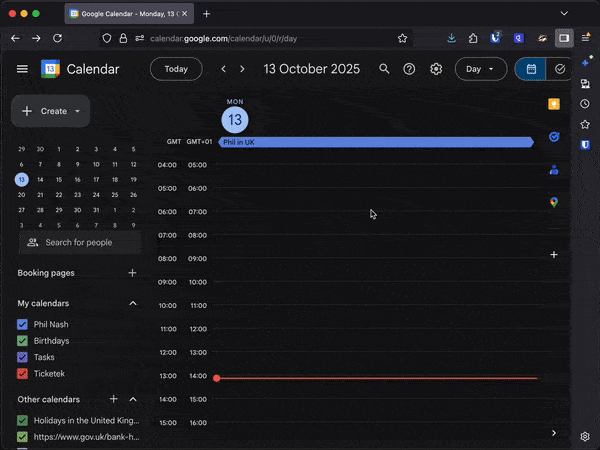
The Power of Choice
One of Langflow's core strengths is model flexibility. You can use any model from any provider. Let's swap out OpenAI's GPT-5 for Google's gemini-2.5-pro. It’s as simple as changing the model provider and model in the Agent component, and then adding a new API key.
We can then continue the conversation with this new model.
"Actually, find that lunch event today and delete it."
The agent, now powered by Gemini, correctly identifies the event we just created and successfully deletes it from the calendar.
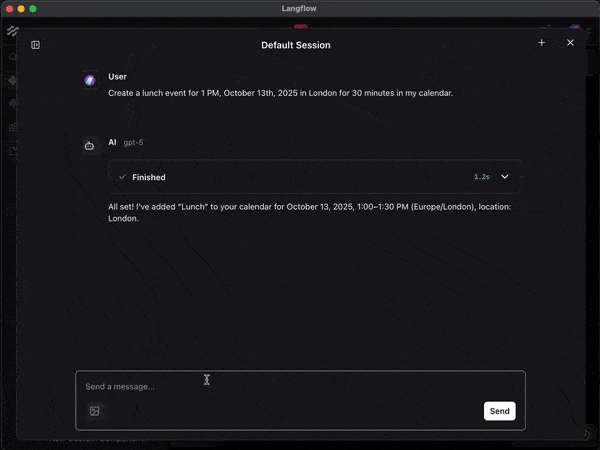
This flexibility extends to open-source and local models. Using Ollama, you could run a model like Llama 3 entirely on your own machine. Langflow itself is a self-hosted server—it offers a Docker container you can deploy anywhere, which is a crucial point we'll return to.
Building with OpenAI's Agent Builder
Now, let's try to follow the same steps to create this agent in Agent Builder.
Start from Scratch
Creating a new workflow gives us a Start node and an Agent component. One immediate difference is that these nodes are configuration-based UI elements, not editable code like in Langflow.
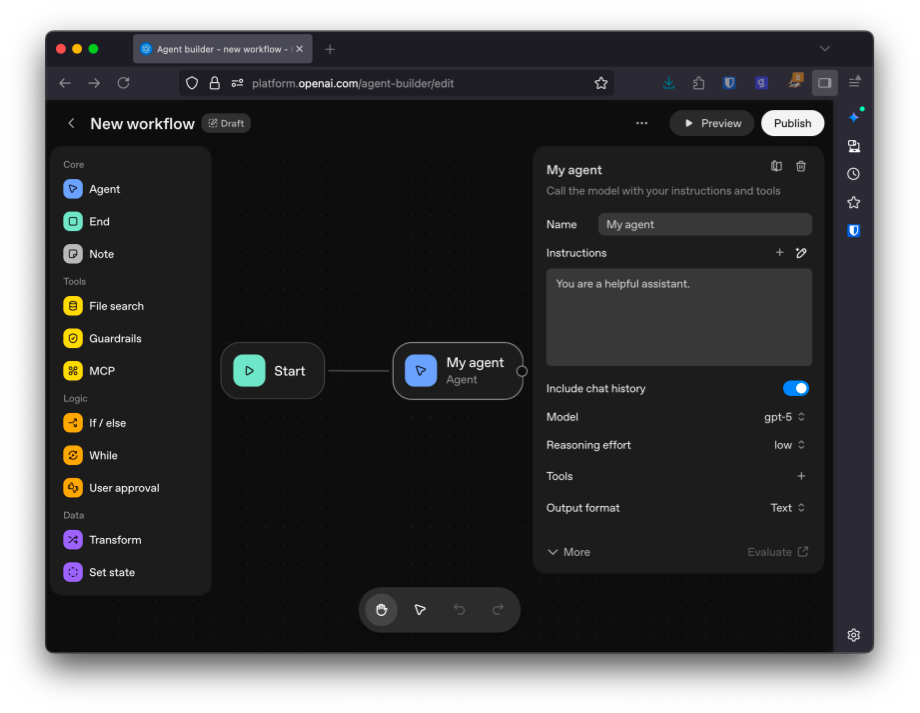
Add Tools
There are a few built-in tools to the Agent component, but the majority of the integrations are connected through MCP servers. There is an OpenAI maintained Google Calendar MCP server which you can add to the agent. You’ll need to provide an access token too.
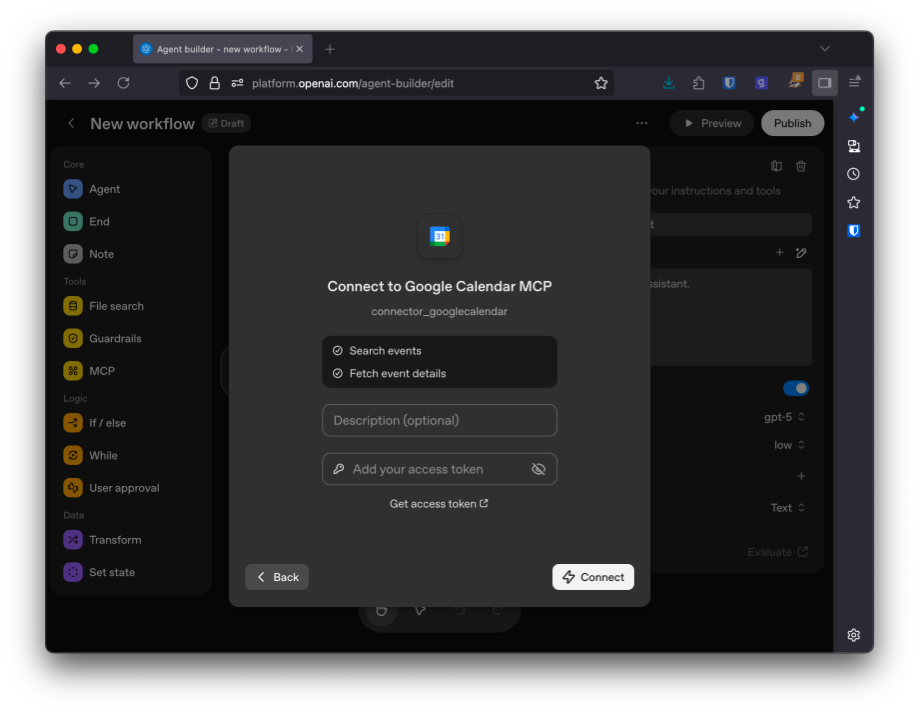
Let’s test it in the Preview.
"Create a lunch event for 1 PM, October 13th, 2025 in Europe/London for 30 minutes in my calendar."
The agent responds that it can't create events directly, though it does provide other options, like a link to the calendar to create an event. It appears that this MCP server does not provide write operations for the calendar.
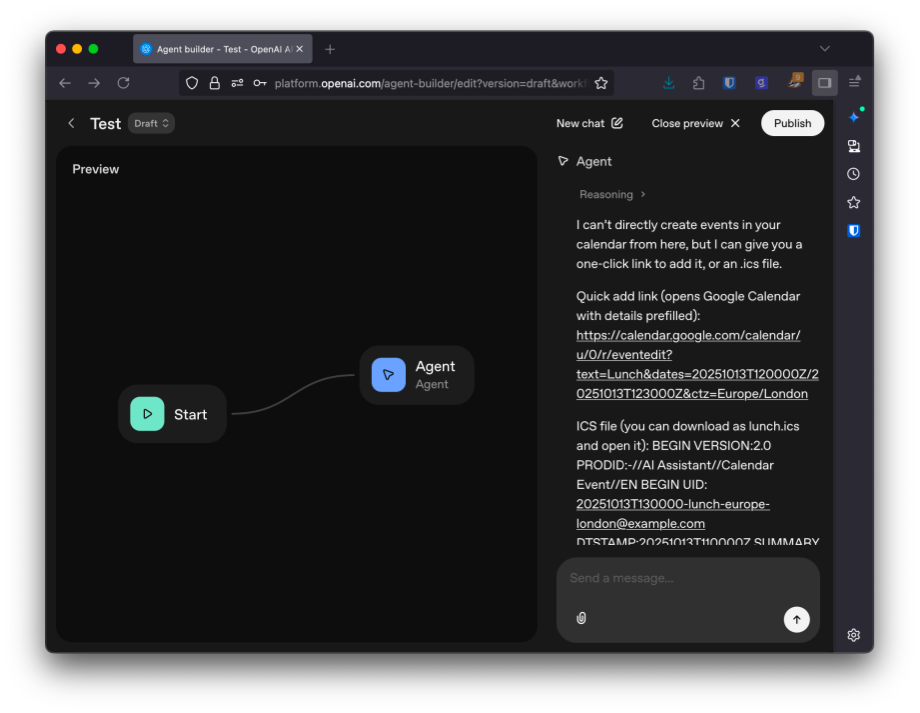
Let’s try a read-only task:
"What events do I have on my calendar today?"
The agent is capable of viewing the calendar, so it reads out the events to us.
The Trade-Offs: When to Use What?
While our build in Agent Builder didn't succeed when trying to write events to the calendar, we were able to get both agents to interact with it. We were able to experience the differences between the platforms and understand some of the trade-offs.
Use OpenAI AgentKit when...
- You want a managed, hosted solution. AgentKit is a cloud product. You sign up and start building. OpenAI handles the hosting, uptime, and maintenance. This is a massive plus for convenience and speed.
- You are deeply invested in the OpenAI ecosystem. If you're already using OpenAI language models, vector stores, embedding models, and other services, Agent Builder provides a seamless, highly integrated experience with great guardrails and safety features.
- Convenience is your top priority. You get an enterprise-ready platform out of the box without worrying about infrastructure.
Use Langflow when...
- You need full control over your data and infrastructure. Langflow is self-hosted. You can run it on-premise, in your own VPC, or in any environment. This is critical for enterprises with strict data privacy requirements or zero-trust architectures.
- You require model flexibility. You are not locked into a single model provider. You can choose the best model for the job, whether it's from OpenAI, Anthropic, Google, Cohere, or an open-source model running locally via Ollama.
- You need deep customization. In Langflow, everything is code. This gives you the power to modify, fork, and extend any component to fit your exact needs.
- You value open-source. Langflow is 100% open-source with an MIT license, giving you the freedom to use and adapt it however you see fit.
Conclusion
Both OpenAI's AgentKit and Langflow are powerful tools designed to help you build the next generation of AI agents. The choice between them isn't about which is better, but which set of trade-offs aligns with your goals.
-
OpenAI AgentKit offers convenience, ecosystem integration, and a managed, enterprise-ready experience at the cost of flexibility and data control.
-
Langflow offers ultimate flexibility, control, and customization through its open-source, self-hosted, and model-agnostic architecture, at the cost of requiring you to manage your own infrastructure.
We hope this comparison has been helpful. The right tool for the job depends on what you're building.
If you found this useful, let us know your thoughts on X. For more discussions like this, be sure to join our Discord community!




